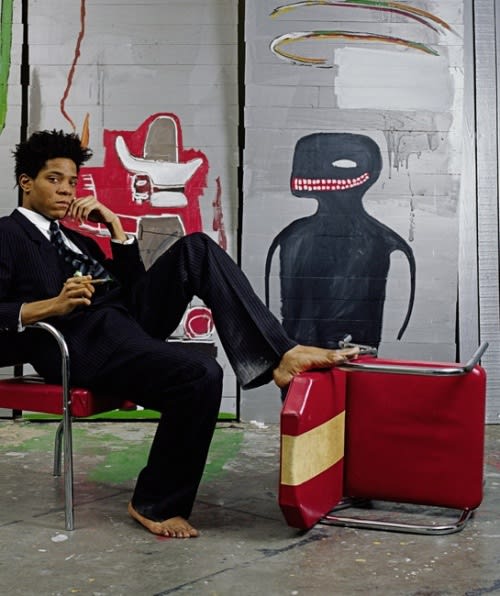Jean-Michel Basquiat was born on December 22, 1960 in Brooklyn, New York. His father, Gerard Basquiat was born in Port-au-Prince, Haiti and his mother, Matilde was born in Brooklyn of Puerto Rican parents. Early on, Basquiat displayed a proficiency in art which was encouraged by his mother. In 1977, Basquiat, along with friend Al Diaz begins spray painting cryptic aphorisms on subway trains and around lower Manhattan and signing them with the name SAMO© (Same Old Shit). "SAMO© as an end to mindwash religion, nowhere politics, and bogus philosophy," "SAMO©saves idiots," "Plush safe he think; SAMO© ."
In 1978 Basquiat left home for good and quit school just one year before graduating form high school. He lived with friends and began selling hand painted postcards and T-shirts. In June of 1980, Basquiat's art was publicly exhibited for the first time in a show sponsored by Colab (Collaborative Projects Incorporated) along with the work of Jenny Holzer, Lee Quinones, Kenny Scharf, Kiki Smith, Robin Winters, John Ahearn, Jane Dickson, Mike Glier, Mimi Gross, and David Hammons. Basquiat continued to exhibit his work around New York City and in Europe, participating in shows along with the likes of Keith Haring, Barbara Kruger.
In December of 1981, poet and artist Rene Ricard published the first major article on Basquiat entitled "The Radiant Child" in Artforum. In 1982, Basquiat was featured in the group show "Transavanguardia: Italia/America" along with Neo-Expressionists Sandro Chia, Francesco Clemente, Enzu Cucchi, David Deutsch, David Salle, and Julian Schnabel (who will go on to direct the biographical film Basquiat in 1996). In 1983 Basquiat had one-artist exhibitions at the galleries of Annina Nosei and Larry Gagosian and was also included in the "1983 Biennial Exhibition" at the Whitney Museum of American Art. It was also in 1983 that Basquiat was befriended by Andy Warhol, a relationship which sparked discussion concerning white patronization of black art, a conflict which remains, to this day, at the center of most discussions of Basquiat's life and work. Basquiat and Warhol collaborated on a number of paintings, none of which are are critically acclaimed. Their relationship continued, despite this, until Warhol's death in 1987.
By 1984, many of Basquiat's friends had become quite concerned about his excessive drug use, often finding him unkempt and in a state of paranoia. Basquiat's paranoia was also fueled by the very real threat of people stealing work from his apartment and of art dealers taking unfinished work from his studio. On February 10, 1985, Basquiat appeared on the cover of The New York Times Magazine, posing for the Cathleen McGuigan article "New Art, New Money: The Marketing of an American Artist." In March, Basquiat had his second one-artist show at the Mary Boone Gallery. In the exhibition catalogue, Robert Farris Thompson spoke of Basquiat's work in terms of an Afro-Atlantic tradition, a context in which this art had never been discussed.
In 1986, Basquiat travelled to Africa for the first time and his work was shown in Abidjan, Ivory Coast. In November, a large exhibition of more than sixty paintings and drawings opened at the Kestner-Gesellschaft in Hannover; at twenty-five Basquiat was the youngest artist ever given an exhibition there. In 1988, Basquiat had shows in both Paris and New York; the New York show was praised by some critics, an encouraging development. Basquiat attempted to kick his heroin addiction by leaving the temptations of New York for his ranch in Hawaii. He returned to New York in June claiming to be drug-free. On August 12, Basquiat died as the result of a heroin overdose. He was 27.

